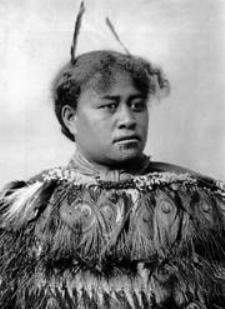Ancient DNA points to Maori feather trade
Kiwi DNA preserved in Maori cloaks reveals the origins and history of the revered textiles.
Ewen Callaway
Source - http://www.nature.com/news/2011/110523/full/news.2011.309.html

The height of nineteenth century Maori fashion.Courtesy of David Lambert
When New Zealand's Maori tribes went into battle, combatants enveloped in kiwi feather cloaks were spared from harm by their foes. The laboriously crafted cloaks, known as Kahu kiwi, were so revered that some were given names — one, called Karamaene, was traded with the Auckland Museum in exchange for a giant wooden war canoe.
Now, kiwi DNA preserved in such cloaks — some dating back to the nineteenth century — has revealed clues to the origin and construction of Kahu kiwi, and hinted at a previously unknown trans-island feather trade1.
David Lambert, an evolutionary geneticist at Griffith University in Nathan, Australia, and lead author on the study, published online in Molecular Biology and Evolution1, says of the cloaks, "They have a remarkable kind of power themselves. They're extraordinary things."
Feather fashion
Records from James Cook's 1769–70 voyage to New Zealand describe flax woven cloaks, the most prestigious of which were adorned with dog skin and worn by Maori chiefs. Kiwi-feather-covered cloaks came into fashion in the early 1800s, but no written records document their origin or construction, Lambert says.
Lambert first worked with the cloaks when his co-author Rangi Te Kanawa, a conservator at the Te Papa Tongarewa Museum in Wellington, New Zealand, presented him with a mysterious cloak she believed to be made from moa feathers. That seemed impossible, Lambert says — the birds were extinct by 1500, hundreds of years before feather cloaks were made. Genetic tests showed the cloak to be woven from emu feathers.
"That kind of got us started," says Lambert, whose team later succeeded in sampling the DNA of kiwi feathers in 109 cloaks housed in museums in New Zealand and the United Kingdom. A previous study2 of the genetic diversity and geographical distribution of the country's five species of kiwi bird, whose feathers can resemble one another, offered a way to map the geographical origin of feathers in a cloak.
Most of the feathers came from the North Island brown kiwi (Apteryx mantelli). Surprisingly, however, 15% of the cloaks were woven partially from kiwi feathers that originated from birds spread across the North island. Lambert says that a trans-island feather trade may have emerged after internecine 'Musket Wars' during the early nineteenth century reconfigured tribal boundaries. As a result, Maori hunters and traders may have looked further afield for kiwi feathers.
Natasha McKinney, curator of Oceania Pacific collections at the British Museum in London, notes that Maori on the South Island traded greenstone (nephrite) with tribes on the North Island well before Europeans arrived, establishing trade routes centuries before the cloaks were made.
Southern spread
The ancient DNA analysis also hints at a potential origin for the tradition of Kahu kiwi, Lambert says. More than one-third of the cloaks contained feathers from a population of birds restricted to a small eastern swath of the North Island. Lambert thinks that this region was the wellspring of cloak-making traditions during the early nineteenth century, and that the craft later spread west and south.
Morten Allentoft, a postdoc in the ancient DNA laboratory at Murdoch University in Perth, Australia, cautions that the study is based on the kiwi's current distribution, and that migrations over the past 200 years could complicate their interpretation.
However, he agrees that the results provide real insight into Maori history. "The ability to trace these old feathers back to a geographic origin is a significant achievement, displaying the kind of detailed insights that can be obtained when you let a molecular biologist into a museum collection," says Allentoft.
-
- Hartnup, K. et al. Mol. Biol. Evol. doi:10.1093/molbev/msr107 (2011).
- Shepherd, L. D. & Lambert, D. M. Mol. Ecol. 17, 2174-2184 (2008).